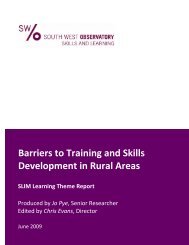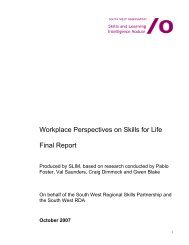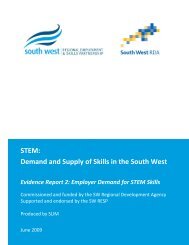Ageless at Work - Skills for Care
Ageless at Work - Skills for Care
Ageless at Work - Skills for Care
You also want an ePaper? Increase the reach of your titles
YUMPU automatically turns print PDFs into web optimized ePapers that Google loves.
5. WIDER INFLUENCES ON THE ADULT SOCIAL CARE SECTOR<br />
Wh<strong>at</strong> has been the impact of the recession on the adult social care sector?<br />
The way official headline st<strong>at</strong>istics are published makes it difficult to accur<strong>at</strong>ely measure the impact of<br />
the recession on the adult social care sector since st<strong>at</strong>istics are usually combined with those <strong>for</strong> other<br />
sectors. Notwithstanding this, there are certainly signs th<strong>at</strong> this broader sector has fared rel<strong>at</strong>ively<br />
well during the recession:<br />
- The health and social care sector grew by 3.3% over the last year – a gre<strong>at</strong>er percentage than<br />
any other sector in the UK (ONS, 2009a)<br />
- The even broader ‘educ<strong>at</strong>ion, health and public administr<strong>at</strong>ion sector’ was the only sector to<br />
report job growth over the past year, had the smallest contraction in vacancies (ONS, 2009b)<br />
and has the lowest redundancy r<strong>at</strong>e (ONS 2009c)<br />
- <strong>Skills</strong> <strong>for</strong> <strong>Care</strong> and Development has reported th<strong>at</strong> ‘overall the recession is increasing demand<br />
<strong>for</strong> many social care services’ (Alliance, 2009)<br />
- The number of vacancies in selected care rel<strong>at</strong>ed occup<strong>at</strong>ions notified to Jobcentre Plus<br />
n<strong>at</strong>ionally increased by 16 percent over the past year. This is in contrast to the fall of 16<br />
percent recorded across all occup<strong>at</strong>ions 14 . One in ten vacancies notified to Jobcentre Plus<br />
n<strong>at</strong>ionally in July 2009 were in care rel<strong>at</strong>ed occup<strong>at</strong>ions.<br />
- N<strong>at</strong>ionally, the number of unfilled vacancies in care work is only slightly higher than the<br />
number of registered jobseekers wanting to work in the sector 15 . This compares to the overall<br />
r<strong>at</strong>io of seven jobseekers <strong>for</strong> every unfilled vacancy registered with the jobcentre.<br />
Regional d<strong>at</strong>a on the impact of the recession on the care sector is restricted to in<strong>for</strong>m<strong>at</strong>ion about the<br />
number of job vacancies notified to the jobcentre and the number of jobseekers looking <strong>for</strong> care<br />
rel<strong>at</strong>ed work. Changes in the number of vacancies <strong>for</strong> care rel<strong>at</strong>ed occup<strong>at</strong>ions, care assistants and<br />
home carers and all occup<strong>at</strong>ions in the South West, over the last two years are illustr<strong>at</strong>ed in Figure 2<br />
(the number of vacancies are indexed <strong>at</strong> 100 <strong>for</strong> July 2007). Two main observ<strong>at</strong>ions can be drawn<br />
from the chart. Firstly, th<strong>at</strong> demand <strong>for</strong> care assistants and home carers has followed a similar trend<br />
to th<strong>at</strong> of all care-occup<strong>at</strong>ions which is not surprising since on average care assistants and home<br />
carers account <strong>for</strong> four in every five care-rel<strong>at</strong>ed vacancies. The second observ<strong>at</strong>ion is th<strong>at</strong> demand<br />
<strong>for</strong> care-rel<strong>at</strong>ed workers followed a similar trend to th<strong>at</strong> of all vacancies notified to the jobcentre until<br />
the summer 2008 – when the recession started - but has subsequently per<strong>for</strong>med r<strong>at</strong>her better. The<br />
number of care-rel<strong>at</strong>ed vacancies notified to jobcentres in the region in July 2009 was 43 percent<br />
higher than the same month two years earlier, compared to a decline of 14 percent in vacancies<br />
across all occup<strong>at</strong>ions.<br />
14 Vacancies in care-rel<strong>at</strong>ed occup<strong>at</strong>ions increased by more than twice the n<strong>at</strong>ional amount (38<br />
percent) in the South West of England over the same period.<br />
15 In July 2009, 32,205 registered jobseekers in England were looking <strong>for</strong> care-rel<strong>at</strong>ed work, and<br />
26,913 unfilled vacancies in care-rel<strong>at</strong>ed occup<strong>at</strong>ions (Jobcentre Plus d<strong>at</strong>a accessed from NOMIS).<br />
<strong>Ageless</strong> <strong>at</strong> <strong>Work</strong>: Change workplace cultures, development skills. Good practice report 47








